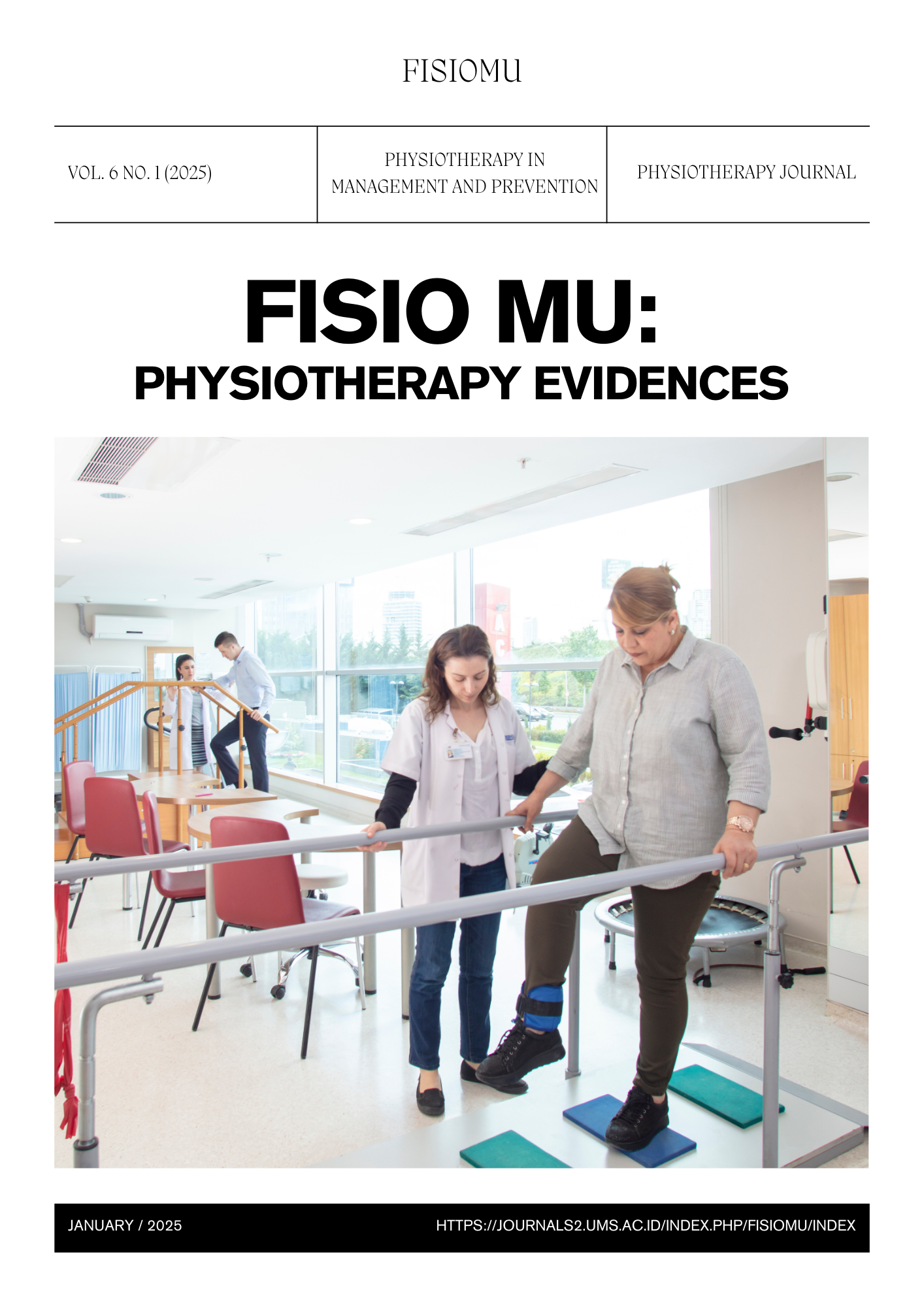The Effect of Active Cycle of Breathing Techniques (ACBT) on Shortness of Breath and Facilitation of Airway Clearance in Obstructive Pulmonary Disease: Literature Review
DOI:
https://doi.org/10.23917/fisiomu.v6i1.7193Keywords:
Active Cycle of Breathing (ACBT), dyspnea, airway clearance, obstructive lung diseaseAbstract
Introduction: Obstructive lung disease is characterised by airflow obstruction due to airway narrowing or damage. The Active Cycle of Breathing Techniques (ACBT) is designed to address issues arising from this by mobilising and clearing secretions from the airways, as well as improving breathing mechanics to reduce dyspnea. This study aims to determine the effect of Active Cycle of Breathing Techniques (ACBT) on dyspnea and airway clearance in cases of obstructive lung disease. Results: A review of 7 previous studies revealed the effects of Active Cycle of Breathing Techniques (ACBT) in reducing dyspnea and clearing the airways in patients with obstructive lung disease. Method: This study uses a literature review method. Articles published from 2014 to 2024, related to the effects of ACBT on airway clearance in patients with obstructive lung disease, were identified through relevant databases (Google Scholar, PubMed, and ScienceDirect) using predetermined keywords. Articles that met inclusion criteria, such as appropriate study design, publication year, and language, were selected for analysis. Results: A review of 7 previous studies revealed the effects of Active Cycle of Breathing Techniques (ACBT) in reducing dyspnea and clearing the airways in patients with obstructive lung disease. Conclusion: There is an impact of Active Cycle of Breathing Techniques (ACBT) exercises in reducing dyspnea and clearing the airways in patients with obstructive lung disease
Downloads
References
Abdel Halim HA, Abo El Naga HH, Fathy KA. 2016. Comparison between active cycles of breathing with postural drainage versus conventional chest physiotherapy in subjects with bronchiectasis. Egyptian Journal of Chest Diseases and Tuberculosis. 65(1):157–165. https://doi.org/10.1016/j.ejcdt.2015.08.006 DOI: https://doi.org/10.1016/j.ejcdt.2015.08.006
Athawale VK, Lalwani LL, Mishra GP. 2021. Comparison of the Active Cycle of Breathing Technique (ACBT) versus the Active Cycle of Breathing Technique with Flutter in Bronchiectasis. National Journal of Medical Research [Internet]. [accessed 2024 Aug 11] 10(4):178–180. https://njmr.in/index.php/file/article/view/88
Baig B, Anwar M, Rasheed M, Rasul A, Fiaz A, Faisal S. 2024. Comparative Effects of Buteyko Breathing Technique and Active Cycle of Breathing Technique on Dyspnea and Quality of Life in Patients with Chronic Obstructive Pulmonary Disease. Journal of Health and Rehabilitation Research. 4(1):250–255. https://doi.org/10.61919/jhrr.v4i1.192 DOI: https://doi.org/10.61919/jhrr.v4i1.192
Budhi A, Arief B, Wiwien Heru W. 2023. Penyakit Paru Obstruktif Kronik (PPOK) Pedoman Diagnosis Dan Penatalaksanaan Di Indonesia. Jakarta: Perhimpunan Dokter Paru Indonesia.
Denny Pratama, A. (2021). Efektivitas Active Cycle Of Breathing Technique (Acbt) Terhadap Peningkatan Kapasitas Fungsional Pada Pasien Bronkiektasis Post Tuberkulosis Paru. Jurnal Vokasi Indonesia, 9(1). Doi:https://doi.org/10.7454/jvi.v9i1.247. DOI: https://doi.org/10.7454/jvi.v9i1.247
Elsayed S, Kamal W, Fathy K. 2015. Impact Of Active Cycle Of Breathing Technique On Functional Capacity In Patient With Bronchiectasis. International Journal of Therapies and Rehabilitation Research. 4(5):287. https://doi.org/10.5455/ijtrr.000000105 DOI: https://doi.org/10.5455/ijtrr.000000105
Gulati M. 2020. An Immediate Effect of Conventional Physiotherapy versus ACBT with Autogenic Drainage on Dyspnoea and Cough in Patient with COPD - A Randomized Control Trial. Int J Res Appl Sci Eng Technol. 8(9):709–713. https://doi.org/10.22214/ijraset.2020.31518 DOI: https://doi.org/10.22214/ijraset.2020.31518
Haider S, Ain QU, Amjad M, Sajjad Y, Javed Z, Kausar F. 2024. Effects of Home-Based Pulmonary Training Program on Functional Exercise Capacity and Quality of Life in Patients with Chronic Obstructive Pulmonary Disease. Journal of Health and Rehabilitation Research. 4(1):1474–1478. https://doi.org/10.61919/jhrr.v4i1.659 DOI: https://doi.org/10.61919/jhrr.v4i1.659
Jaime CP, Michele PW. 2014. Acute Care Handbook for Physical Therapists. [place unknown]: Elsevier. https://doi.org/10.1016/C2011-0-05707-1 DOI: https://doi.org/10.1016/C2011-0-05707-1
Martinez-Pitre PJ, Sabbula BR, Cascella M. 2023. Restrictive Lung Disease [Internet]. https://www.ncbi.nlm.nih.gov/books/NBK560880/
Reina-Gutiérrez S, Torres-Costoso A, Martínez-Vizcaíno V, Núñez de Arenas-Arroyo S, Fernández-Rodríguez R, Pozuelo-Carrascosa DP. 2021. Effectiveness of Pulmonary Rehabilitation in Interstitial Lung Disease, Including Coronavirus Diseases: A Systematic Review and Meta-analysis. Arch Phys Med Rehabil. 102(10):1989-1997.e3. https://doi.org/10.1016/j.apmr.2021.03.035 DOI: https://doi.org/10.1016/j.apmr.2021.03.035
Saeed A, Arshad MU, . W, Khalid MU, Shahid A. 2022. A Review on Implications of Physiotherapy Techniques in COPD: A Review Article. Pakistan Journal of Medical and Health Sciences. 16(10):3–5. https://doi.org/10.53350/pjmhs2216103 DOI: https://doi.org/10.53350/pjmhs2216103
Salehi Derakhtanjani A, Ansari Jaberi A, Haydari S, Negahban Bonabi T. 2019. Comparison the Effect of Active Cyclic Breathing Technique and Routine Chest Physiotherapy on Pain and Respiratory Parameters After Coronary Artery Graft Surgery: A Randomized Clinical Trial. Anesth Pain Med. 9(5). https://doi.org/10.5812/aapm.94654 DOI: https://doi.org/10.5812/aapm.94654
Uzmezoglu B, Altiay G, Ozdemir L, Tuna H, Sut N. 2018. The Efficacy of Flutter® and Active Cycle of Breathing Techniques in Patients with Bronchiectasis: A Prospective, Randomized, Comparative Study. Turk Thorac J. https://doi.org/10.5152/TurkThoracJ.2018.17050 DOI: https://doi.org/10.5152/TurkThoracJ.2018.17050
Downloads
Submitted
Accepted
Published
How to Cite
Issue
Section
License
Copyright (c) 2024 Fisio Mu : Physiotherapy Evidaces Journal

This work is licensed under a Creative Commons Attribution-NonCommercial-NoDerivatives 4.0 International License.

This work is licensed under a Creative Commons Attribution-NonCommercial 4.0 International License.
Authors who publish with FISIO MU: Phsiotherapy Evidences agree to the following terms:
- Author(s) retain copyright and grant the journal right of first publication with the work simultaneously licensed under a Creative Commons Attribution-NonCommercial 4.0 International License that allow others to share the work within an acknowledgement of the work’s authorship and initial publication of this journal.
- Author(s) are able to enter into separate, additional contractual arrangement for the non-exclusive distribution of the the journal’s published version of the work (e.g. acknowledgement of its initial publication in this journal).
- Author(s) are permitted and encouraged to post their work online (e.g. in institutional repositories or on their websites) prior to and during the submission process, as it can lead to productive exchanges, as well as earlier and greater citation of published works.












